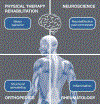Reconnecting the Brain With the Rest of the Body in Musculoskeletal Pain Research
- PMID: 32553621
- PMCID: PMC7736274
- DOI: 10.1016/j.jpain.2020.02.006
Reconnecting the Brain With the Rest of the Body in Musculoskeletal Pain Research
Abstract
A challenge in understanding chronic musculoskeletal pain is that research is often siloed between neuroscience, physical therapy/rehabilitation, orthopedics, and rheumatology which focus respectively on 1) neurally mediated effects on pain processes, 2) behavior and muscle activity, 3) tissue structure, and 4) inflammatory processes. Although these disciplines individually study important aspects of pain, there is a need for more cross-disciplinary research that can bridge between them. Identifying the gaps in knowledge is important to understand the whole body, especially at the interfaces between the silos-between brain function and behavior, between behavior and tissue structure, between musculoskeletal and immune systems, and between peripheral tissues and the nervous system. Research on "mind and body" practices can bridge across these silos and encourage a "whole person" approach to better understand musculoskeletal pain by bringing together the brain and the rest of the body. PERSPECTIVE: Research on chronic musculoskeletal pain is limited by significant knowledge gaps. To be fully integrated, musculoskeletal pain research will need to bridge across tissues, anatomical areas, and body systems. Research on mind and body approaches encourages a "whole person" approach to better understand musculoskeletal pain.
Keywords: Musculoskeletal pain; chronic pain; connective tissue; mind and body practices; muscle.
Published by Elsevier Inc.
Conflict of interest statement
Disclosures: No funding sources were provided. There are no conflicts to report.
Figures
Similar articles
-
On the body-mind nexus in chronic musculoskeletal pain: A scoping review.Eur J Pain. 2022 Jul;26(6):1186-1202. doi: 10.1002/ejp.1944. Epub 2022 Apr 4. Eur J Pain. 2022. PMID: 35315163
-
Unraveling the role of fear and avoidance behavior in chronic musculoskeletal pain: from theory to physical therapy clinical practice.Braz J Phys Ther. 2025 May-Jun;29(3):101197. doi: 10.1016/j.bjpt.2025.101197. Epub 2025 Mar 22. Braz J Phys Ther. 2025. PMID: 40121905 Free PMC article. Review.
-
Chronic Pain: Where the Body Meets the Brain.Trans Am Clin Climatol Assoc. 2015;126:167-83. Trans Am Clin Climatol Assoc. 2015. PMID: 26330672 Free PMC article. Review.
-
Core Outcome Measures for Chronic Musculoskeletal Pain Research: Recommendations from a Veterans Health Administration Work Group.Pain Med. 2019 Aug 1;20(8):1500-1508. doi: 10.1093/pm/pny279. Pain Med. 2019. PMID: 30615172
-
Fear-avoidance model of chronic musculoskeletal pain: 12 years on.Pain. 2012 Jun;153(6):1144-1147. doi: 10.1016/j.pain.2011.12.009. Epub 2012 Feb 8. Pain. 2012. PMID: 22321917 No abstract available.
Cited by
-
Identifying Motor Control Strategies and Their Role in Low Back Pain: A Cross-Disciplinary Approach Bridging Neurosciences With Movement Biomechanics.Front Pain Res (Lausanne). 2021 Aug 11;2:715219. doi: 10.3389/fpain.2021.715219. eCollection 2021. Front Pain Res (Lausanne). 2021. PMID: 35295522 Free PMC article.
-
Postural control and trunk stability on sway parameters in adults with and without chronic low back pain.Eur Spine J. 2024 Apr;33(4):1455-1464. doi: 10.1007/s00586-024-08147-3. Epub 2024 Feb 19. Eur Spine J. 2024. PMID: 38374241
-
Implications for fall efficacy strategies on center of pressure and center of gravity sway distances in adults with chronic low back pain.Eur Spine J. 2024 Dec;33(12):4581-4590. doi: 10.1007/s00586-024-08523-z. Epub 2024 Oct 26. Eur Spine J. 2024. PMID: 39460759
-
An exploration of knowledge-organizing technologies to advance transdisciplinary back pain research.JOR Spine. 2023 Nov 29;6(4):e1300. doi: 10.1002/jsp2.1300. eCollection 2023 Dec. JOR Spine. 2023. PMID: 38156063 Free PMC article.
-
Postural adaptations within normalized stability between older adults with and without chronic low back pain.Eur Spine J. 2023 Dec;32(12):4420-4427. doi: 10.1007/s00586-023-07939-3. Epub 2023 Sep 17. Eur Spine J. 2023. PMID: 37718340
References
-
- Akeson WH, Amiel D, Woo SL. Immobility effects on synovial joints the pathomechanics of joint contracture. Biorheology 17:95–110, 1980 - PubMed
MeSH terms
Grants and funding
LinkOut - more resources
Full Text Sources
Other Literature Sources
Medical


